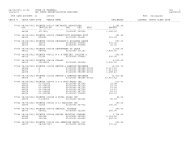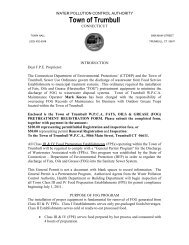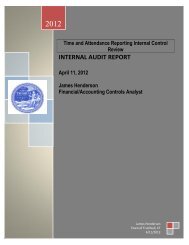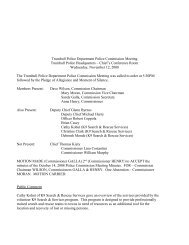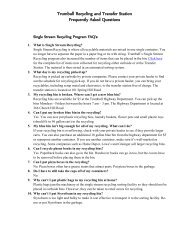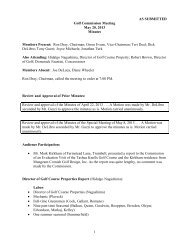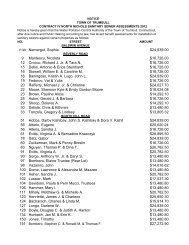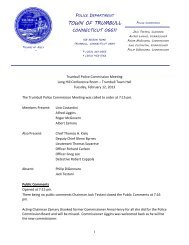Forensic Audit Report-WPCA Phase IV, Part B. Contract ... - Trumbull
Forensic Audit Report-WPCA Phase IV, Part B. Contract ... - Trumbull
Forensic Audit Report-WPCA Phase IV, Part B. Contract ... - Trumbull
You also want an ePaper? Increase the reach of your titles
YUMPU automatically turns print PDFs into web optimized ePapers that Google loves.
<strong>Forensic</strong> Consulting Services <strong>Report</strong><br />
Town of <strong>Trumbull</strong>, Connecticut<br />
Page 42<br />
application, nor the prior approval and/or authorized expenditures of such funds by the Town’s<br />
<strong>WPCA</strong>.<br />
Similar concerns and lack of documentation are found in regards to the additional work related to the<br />
“Jog Hill Extension”, which has been reported to have added approximately $3.0 to $3.5 million of<br />
utility work to <strong>Contract</strong> 3. Although there is some documentation relating to general discussions,<br />
public hearings and an approval process performed within the Town (i.e. <strong>WPCA</strong>, Finance<br />
Committee, Town Council, etc.), there are no executed change orders or supplemental agreements to<br />
<strong>Contract</strong> 3 quantifying the amount of work added, the specific locations of application, nor any<br />
contractual adjustment (increase) to the overall contract quantities, dollar amount and/or time for<br />
completion. Again this appears to be in direct violation to the provisions set forth under Section 14<br />
of <strong>Contract</strong> 3 “General Conditions” where it specifically states “The contract price or time may be<br />
changed only by a change order”.<br />
Based on the contractor’s “Application for Payments” it appears that once the “Extension” was<br />
apparently approved for implementation, the contractor simply extended the unit items within the<br />
original base <strong>Contract</strong> 3, as well as possibly the “Supplementary Unit Prices”, creating what is now<br />
shown to be significant overruns in quantities and costs on numerous line items. Again financially,<br />
this is viewed as an open-ended approach to the construction management of <strong>Contract</strong> 3. The<br />
addition of such work without the proper change order documentation executed between both parties<br />
of <strong>Contract</strong> 3 (the <strong>Contract</strong>or and the Town) presents significant concerns of overall accountability<br />
and oversight on the part of the Town, specifically the <strong>WPCA</strong>.<br />
The above discrepancies and lack of change order protocols may account for the variation of<br />
contract values as indicated on the <strong>Contract</strong>or’s most recent Application for Payment No. 27, dated<br />
11/11/2009. In comparing the “Total Completed & Stored to Date” dollars ($20,680,582.06) to the<br />
“<strong>Contract</strong> Sum to Date” dollars ($17,059,650.20), the “Total Completed” exceeds the “<strong>Contract</strong><br />
Sum” by $3,620,931.86 without any documented explanation as to why. By rights, the total<br />
“<strong>Contract</strong> Sum”, inclusive of all previously approved and executed change orders should reflect and<br />
be equal to the total expenditures approved and authorized by the Town under <strong>Contract</strong> 3. As such<br />
the “<strong>Contract</strong> Sum” serves as the “not-to-exceed” ceiling for the overall contract. Establishing and<br />
maintaining this “not-to-exceed” limit is critical to the Town as the funding entity, as well as the<br />
contractor looking to be paid, since it reflects the total amount of available funds committed and/or<br />
otherwise appropriated for the project. Failure to maintain such controls exposes the Town to over<br />
spending the budgetary constraints of the appropriation, thus creating the need to seek additional<br />
funds to meet the payment commitments of the contract.<br />
Naturally as individual change orders are processed and approved based on available funding, the<br />
“<strong>Contract</strong> Sum” is adjusted based on the net increase or decrease of the change order being<br />
processed. Unfortunately, this type of contract administration, which is accepted practices under<br />
construction and general accounting management, was not used for <strong>Contract</strong> 3.



